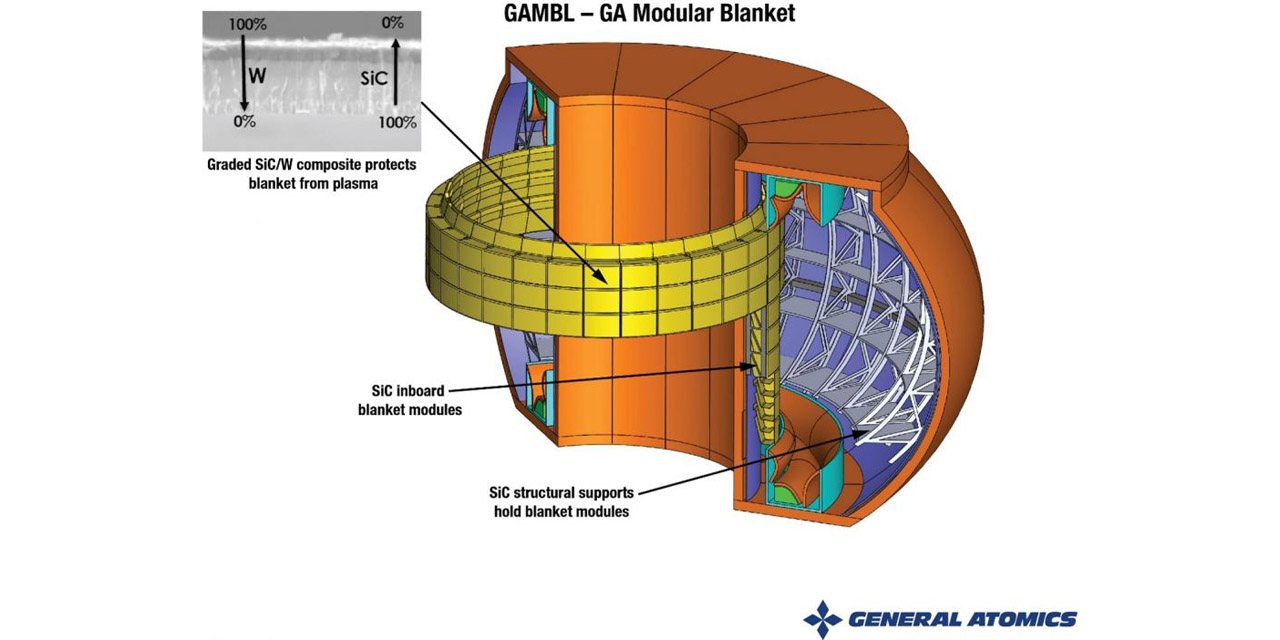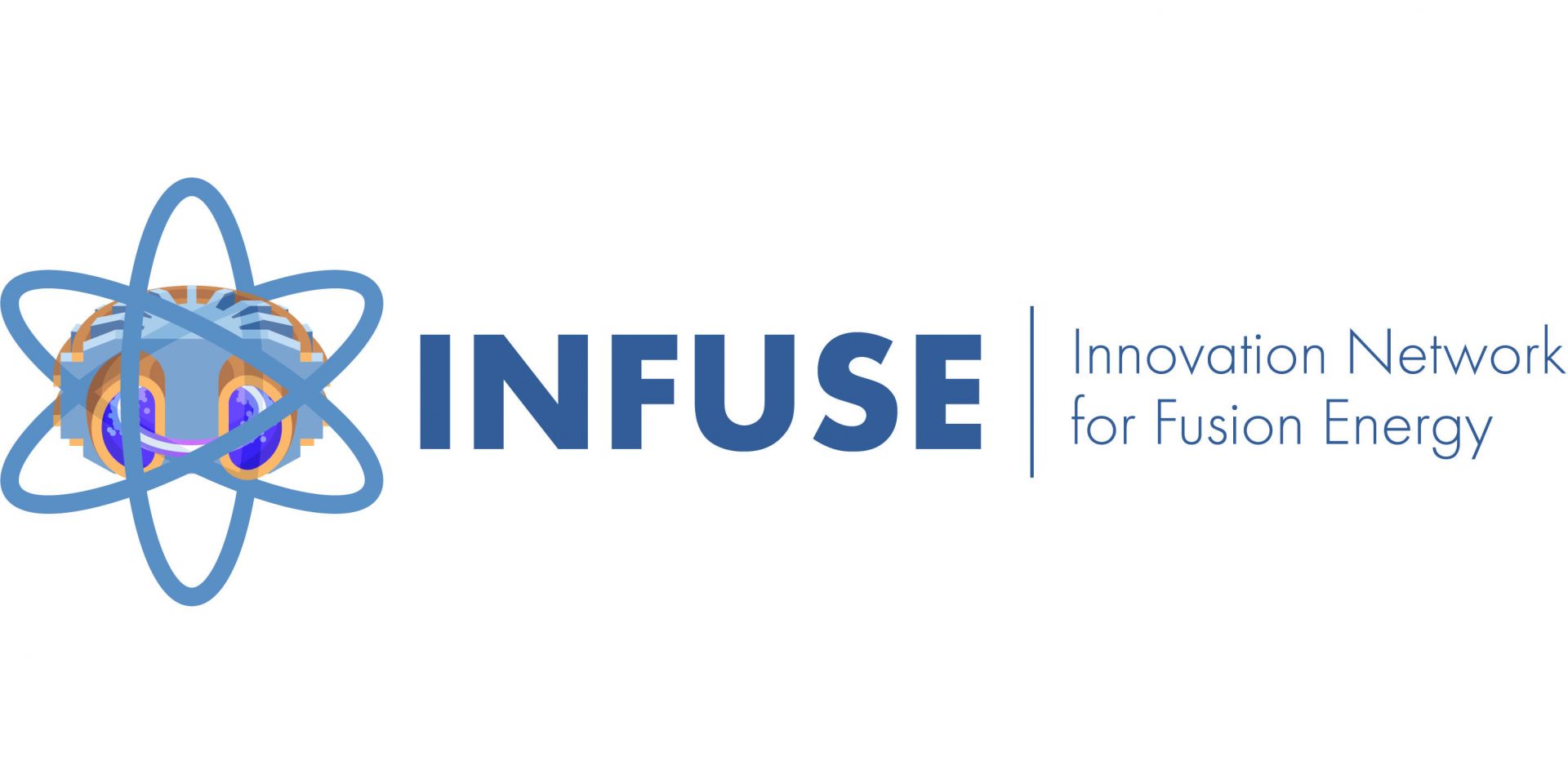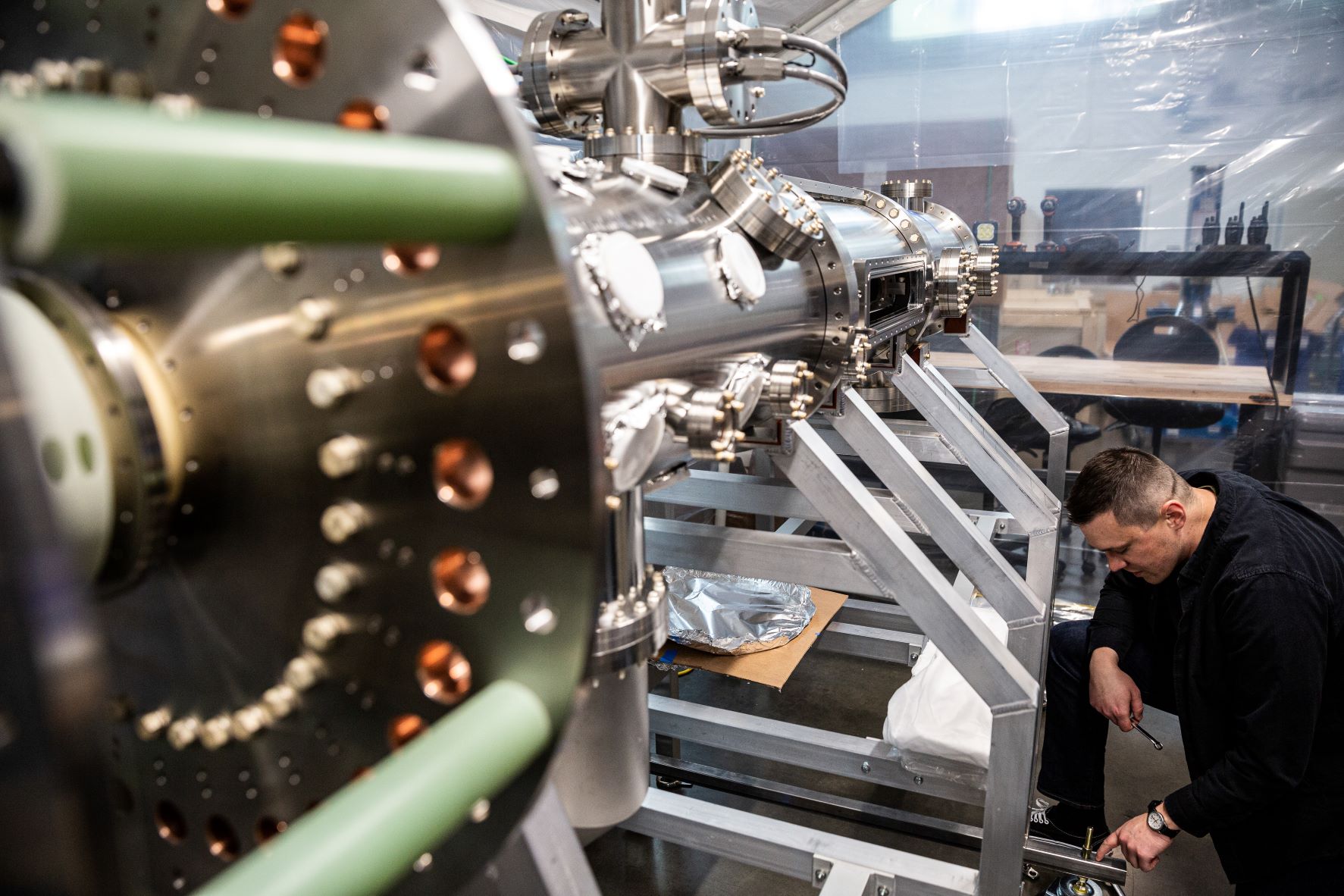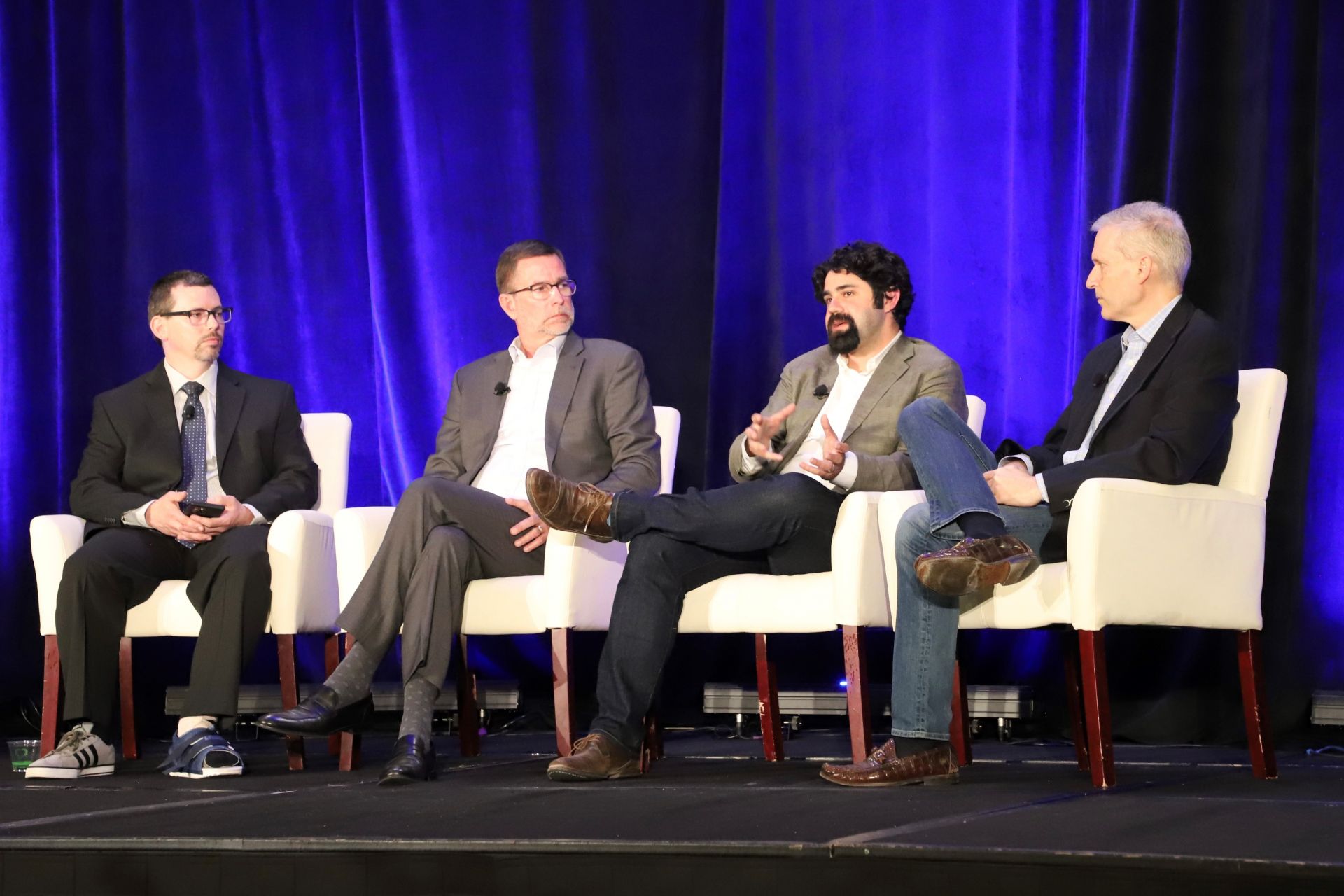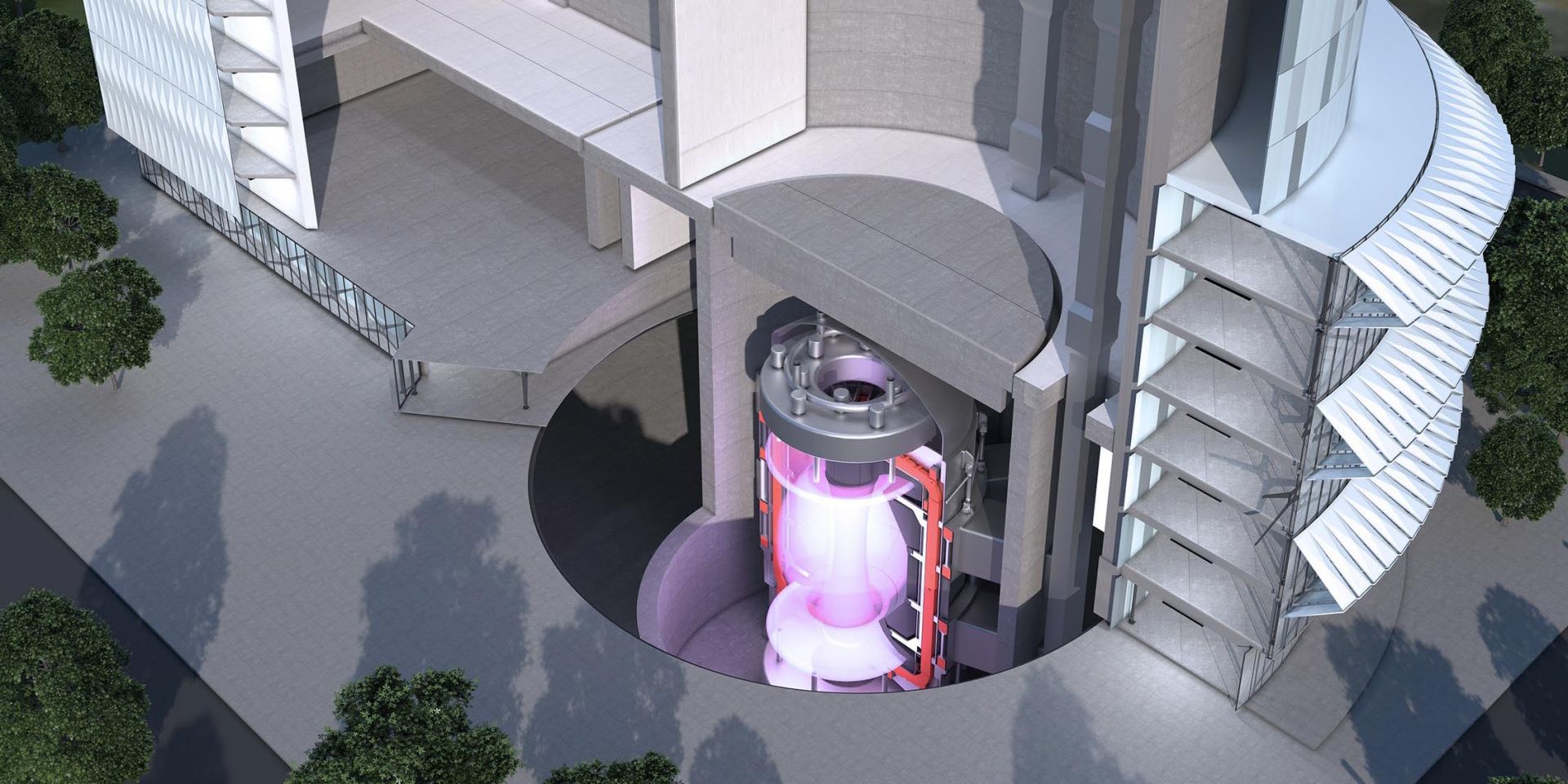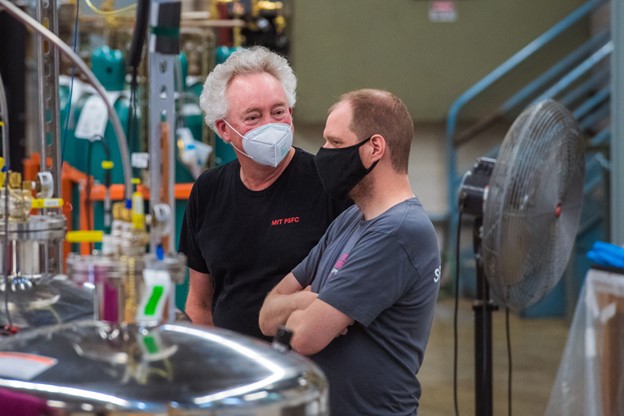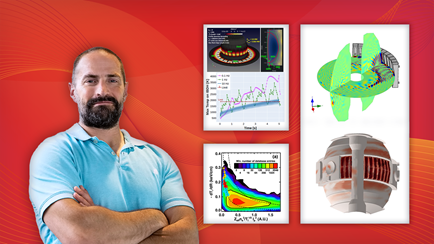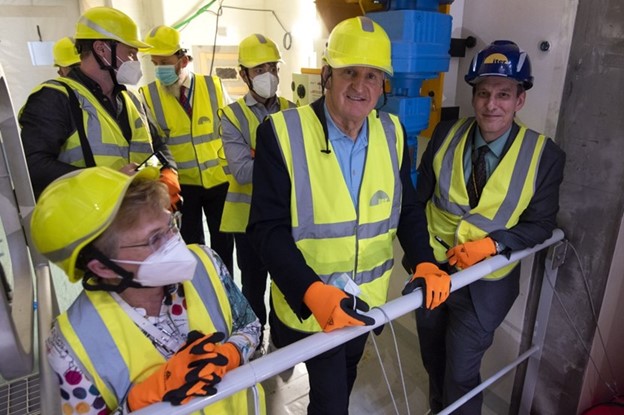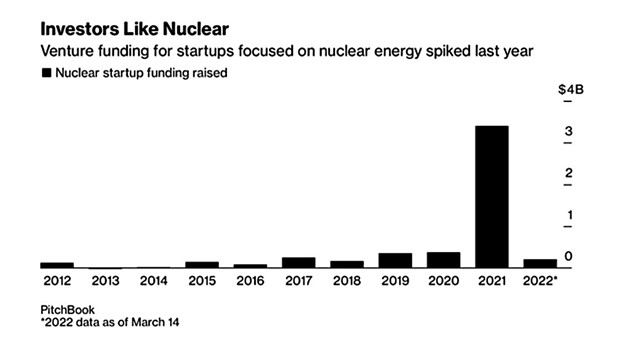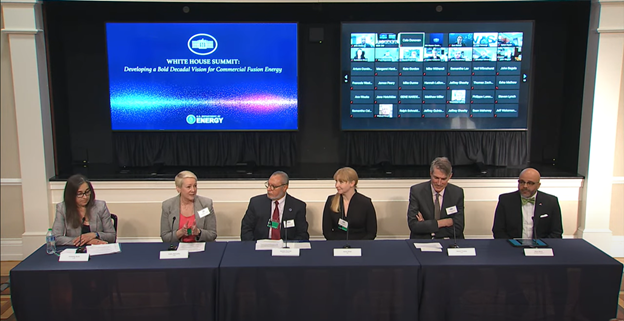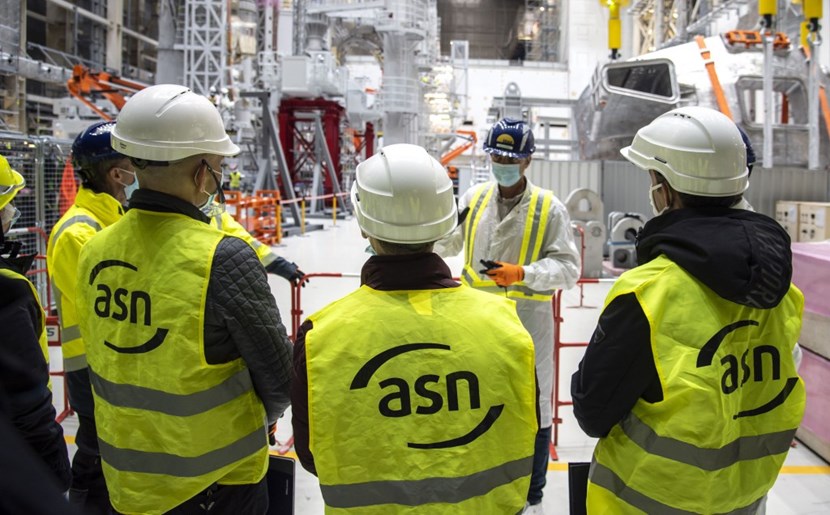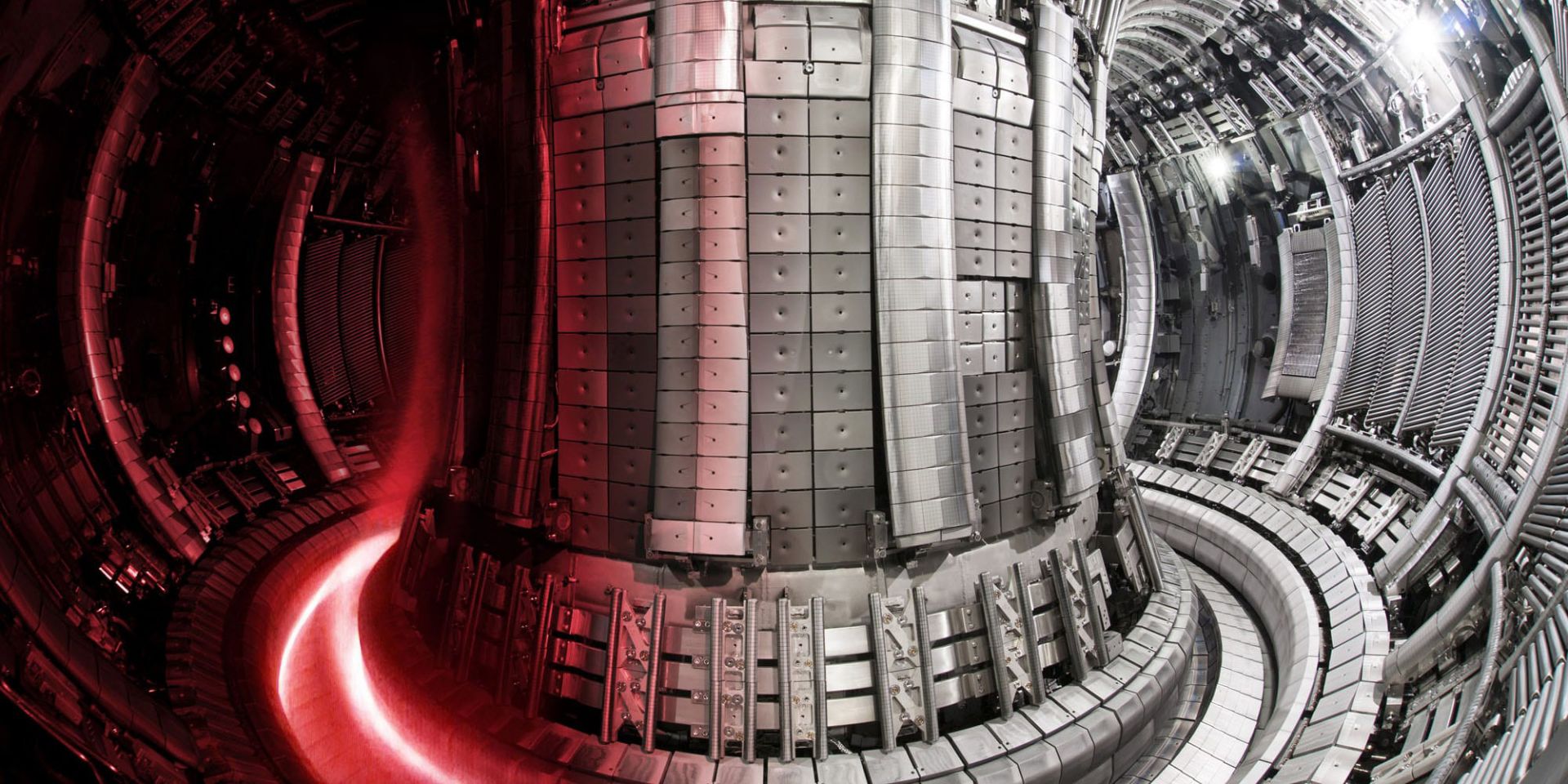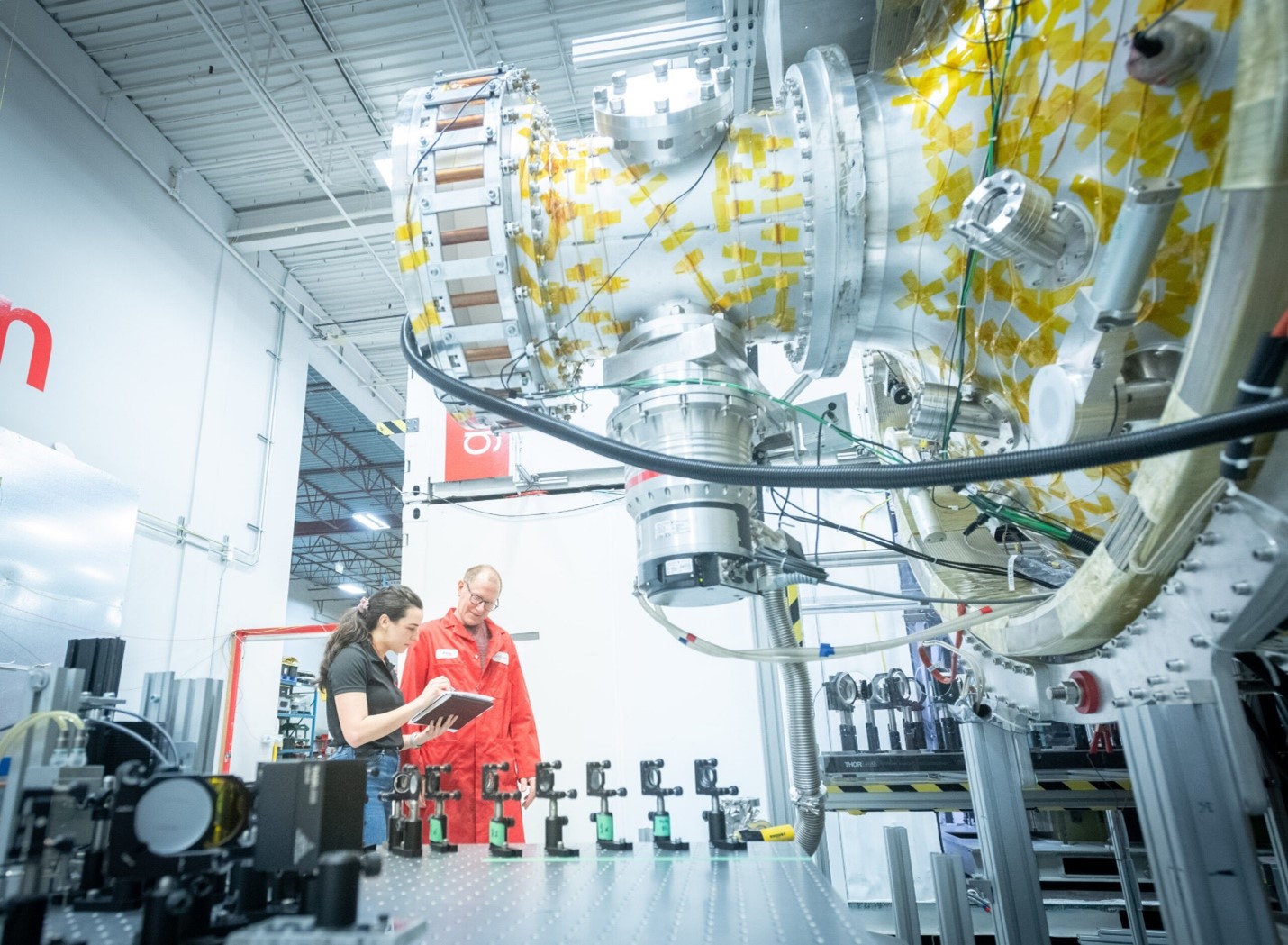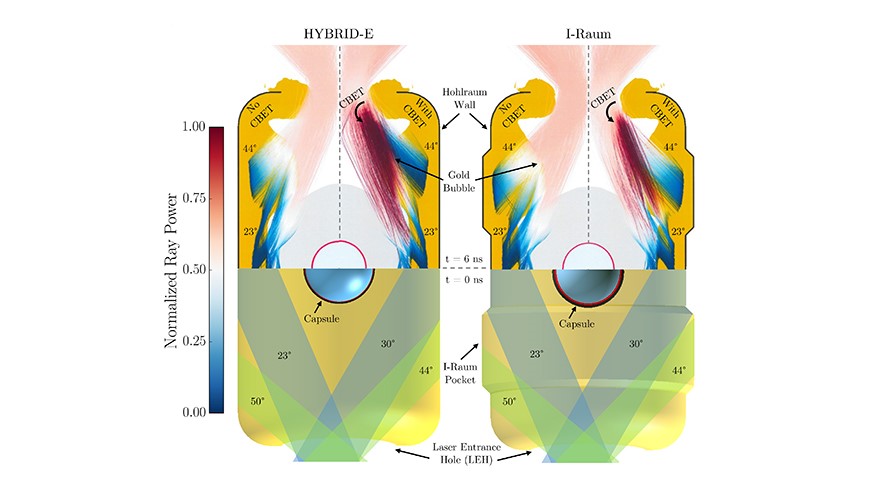This fusion tokamak cutaway illustrates how the GAMBL concept would be incorporated into a fusion pilot plant. The SiC-tungsten composite wall provides superior heat-removal capabilities and durability, and a modular approach enables fabrication using existing technologies. (Image: GA)
Researchers at General Atomics (GA) are proposing a breeding blanket made of modular silicon carbide–based components to withstand the intense conditions in a high-power fusion power plant. The GA modular blanket (GAMBL) concept is described in an article published this month in the journal Fusion Engineering and Design, and was introduced by GA in a July 13 press release.
The Department of Energy announced awards for 18 Innovation Network for Fusion Energy (INFUSE) projects on July 6 that link private fusion energy developers with DOE national laboratories (and, in a first for the program, with U.S. universities) to overcome scientific and technological challenges in fusion energy development. The 18 selected projects include representation from 10 private companies, three national labs, and eight universities.
The first plasmas created in FuZE-Q, shown here during assembly, represent a key step towards fusion experiments with net energy output. (Photo: Zap Energy)
Zap Energy has created the first plasmas in its FuZE-Q machine—the company’s fourth prototype machine and the one it hopes will demonstrate a net energy gain from a Z-pinch fusion plasma just one millimeter in diameter and half a meter long. Zap Energy announced that engineering achievement and the close of $160 million in Series C funding in late June.
The Spherical Tokamak for Energy Production (STEP), shown here, is a government-backed prototype fusion energy plant planned for operation in the U.K. in the early 2040s. (Image: UKAEA)
Future fusion energy facilities will continue to be regulated by the Environment Agency (EA) and Health & Safety Executive (HSE), the U.K. government announced June 20, and existing law on nuclear regulations will be amended to exclude fusion energy facilities from nuclear fission regulatory and licensing requirements. The move was announced by the United Kingdom Atomic Energy Authority (UKAEA) with the expectation it would provide “clarity to developers of prototype/demonstration fusion facilities currently being planned to support rapid commercialization.”
Ambassador Philippe Étienne (sixth from left) and staff from the Consulate General of France with senior leaders from General Atomics at the GA Magnet Technologies Center in Los Angeles. In the background are two partially completed ITER central solenoid modules. (Photo: GA)
General Atomics’ Magnet Technologies Center in Poway, Calif., played host last week to French ambassador Philippe Étienne, the company announced June 16. During the visit, which was hosted by Vivek Lall, chief executive of the General Atomics Global Corporation, Étienne viewed ITER central solenoid modules—all destined for shipment to France—in several stages of the fabrication process.
“General Atomics and French organizations have a strong relationship in both the defense and energy sectors, as well as in the unmanned field, that meet both France’s and the United States’ important interests,” Étienne remarked during his visit.
Session moderator Scott Hsu (left) led a discussion with (from left) Troy Carter, Kathy McCarthy, Artem Smirnov, Satoshi Konishi, and Jane Hotchkiss during an ANS Annual Meeting executive session on “The New Fusion Outlook.”
A “bold decadal plan” to accelerate fusion research, development, and demonstration in partnership with the private sector emerged from a March 2022 White House Fusion Summit and inspired the June 14 ANS Annual Meeting executive session titled “The New Fusion Outlook.” Moderator Scott Hsu, who is leaving a role as a program director for the Department of Energy’s Advanced Research Projects Agency–Energy (ARPA-E) to become a senior adviser to the DOE’s undersecretary for science and innovation as well as lead fusion coordinator for the DOE, ably led a panel of fusion stakeholders representing universities, national laboratories, private fusion companies, and public policy and communication. The discussion intended to bring attendees with fission experience up to speed on the rapidly accelerating area of fusion energy and explore how the fusion energy community can work toward a unique path for fusion energy regulation and public engagement.
Panelists (from left) Adam Stein, Jon Ball, Mike Laufer, and Michl Binderbauer during the Breaking Through: Assessing the Current State and Prospects of Nuclear Innovation in the Race to Decarbonize session at the ANS Annual Meeting.
If nuclear innovators are in a race to decarbonize, it is a race with one finish line—affordable, clean, and reliable power—and many ways to get there. Over 40 fission developers and 20 fusion developers are in the running, and while attendees of the June 13 ANS Annual Meeting executive session on Breaking Through: Assessing the Current State and Prospects of Nuclear Innovation in the Race to Decarbonize heard from representatives of just three of those companies, they presented very different designs and deployment approaches, aptly reflecting the broader diversity of nuclear power innovation.
Session chair Adam Stein, director of nuclear energy innovation at the Breakthrough Institute, welcomed representatives from an advanced non–light water reactor developer (Mike Laufer, Kairos Power), a small modular light water reactor developer (Jon Ball, GE Hitachi Nuclear Energy), and a fusion power developer (Michl Binderbauer, TAE Technologies). Together they explored the challenge of engineering a significant commercial scale-up of advanced nuclear technology by the end of the decade, tackling questions of cost, schedule, supply chain, regulation, and more.
Government policies and innovative technologies are the key to fusion energy economics
May 27, 2022, 4:38PMNuclear NewsBart Gordon, Tim Peckinpaugh, Mike O’Neill, and Molly Barker Artist’s rendering of the U.K.'s STEP fusion reactor. (Image: U.K. Atomic Energy Authority)
Fusion energy is attracting significant interest from governments and private capital markets. The deployment of fusion energy on a timeline that will affect climate change and offer another tool for energy security will require support from stakeholders, regulators, and policymakers around the world. Without broad support, fusion may fail to reach its potential as a “game-changing” technology to make a meaningful difference in addressing the twin challenges of climate change and geopolitical energy security.
The process of developing the necessary policy and regulatory support is already underway around the world. Leaders in the United States, the United Kingdom, the European Union, China, and elsewhere are engaging with the key issues and will lead the way in setting the foundation for a global fusion industry.
Artist’s rendering of USNC spacecraft using EmberCore. (Image: DIU)
The Defense Innovation Unit (DIU), a Department of Defense organization focused on swiftly putting commercial technology to use in the U.S. military, has awarded contracts for two nuclear technologies—compact fusion and radioisotope heat—for spacecraft that could carry a high-power payload and freely maneuver in cislunar space. The objective is to accelerate ground and flight testing and launch a successful orbital prototype demonstration of each approach in 2027.
PSFC director Dennis Whyte (left) and CFS chief executive officer Bob Mumgaard in the test hall at MIT’s Plasma Science and Fusion Center. (Photo: Gretchen Ertl, CFS/MIT-PSFC)
The Massachusetts Institute of Technology’s Plasma Science and Fusion Center (PSFC) recently announced it will expand its involvement in fusion energy research and education under a new five-year agreement with Commonwealth Fusion Systems (CFS), a fusion energy company that got its start at MIT and is now building what it says will be the world’s first net-energy fusion machine—the demo-scale SPARC.
“CFS will build SPARC and develop a commercial fusion product, while MIT PSFC will focus on its core mission of cutting-edge research and education,” said PSFC director Dennis Whyte in describing the collaboration.
[CLICK to see entire image] Overview of the SAS-VW program at DIII-D. A research concept map illustrates how intense plasma exhaust power entering the divertor leads to the emergence of impurities that can migrate into the plasma core. After identifying the research requirements for the SAS-VW, a process of engineering design, prototyping, and implementation is performed. (Image: General Atomics)
Researchers at the DIII-D National Fusion Facility (DIII-D) are preparing to test a new method that could enable future fusion power plants to withstand the heat and particle flow created by the fusion reaction, General Atomics reported this week.
PPPL physicist Walter Guttenfelder with figures from the paper he coauthored with members of the NSTX-U team and 23 collaborative institutions worldwide. (Photo: Elle Starkman/PPPL Office of Communications. Collage: Kiran Sudarsanan)
According to the Department of Energy’s Princeton Plasma Physics Laboratory, recent simulations and analysis demonstrate that the design of its flagship fusion facility, the National Spherical Torus Experiment Upgrade (NSTX-U), which is currently under repair, could serve as a model for an economically attractive next-generation fusion pilot plant.
U.S. Sen. Joe Manchin (center) tours the ITER site with ITER chief scientist Tim Luce. (Photo: ITER)
“We cannot eliminate our way to net zero,” said Sen. Joe Manchin (D., W.Va.) during a visit to the ITER site in Cadarache, France, on March 25. “We have to innovate, not eliminate, our way to carbon neutrality."
Manchin was joined by Ali Nouri, assistant secretary for congressional and intergovernmental affairs at the Department of Energy; Kathy McCarthy, director of the U.S. ITER Project Office; and other U.S. officials for a tour of the ITER Assembly Hall led by ITER chief scientist Tim Luce, head of the ITER Science and Operations Domain. The visit was described in an ITER Newsline article published on March 28.
Data from research firm PitchBook show a spike in nuclear investment. (Graph: Bloomberg)
The trend of big-tech billionaires of Silicon Valley investing in next-generation nuclear energy startup companies continues. In a March 22 article on the Bloomberg website, Lizette Chapman, of the site’s venture capital group, writes that these investors view nuclear power as “a solution to both cutting carbon emissions and weaning the world off now-controversial Russian gas.”
A panel on the status and benefits of fusion technology featured, from left, Kimberly Budil (moderator), of Lawrence Livermore National Laboratory; Kathy McCarthy, of Oak Ridge National Laboratory; Abdalla Darwish, of Dillard University; Anne White, of the Massachusetts Institute of Technology; Steven Cowley, of Princeton Plasma Physics Laboratory; and Mark Berry, of Southern Company.
The White House Office of Science and Technology Policy and the Department of Energy cohosted the White House Summit on Developing a Bold Decadal Vision for Commercial Fusion Energy on March 17. The livestreamed event brought together fusion leaders from government, industry, academia, and other stakeholder groups to showcase recent achievements in fusion research and discuss the administration’s strategy to support the development of commercial fusion energy. Energy Secretary Jennifer Granholm’s announcement of a new agency-wide fusion energy initiative and a funding opportunity worth $50 million for magnetic confinement fusion research made March 17 a lucky day indeed for the U.S. fusion energy community.
Approval from French regulator ASN is required before ITER vacuum vessel welding can begin. (Photo: ITER)
In a February 28 article posted on the ITER Organization website, Gilles Perrier, head of ITER’s Safety and Quality Department, addressed the decision by French nuclear safety regulator ASN (Autorité de sûreté nucléaire) to delay the anticipated February 1 release of a preset tokamak assembly “hold point.”
The interior of JET with a superimposed plasma. (Image: EUROfusion)
A new record has been set by the world’s largest operating tokamak, the Joint European Torus (JET). According to the EUROfusion scientists and engineers who work on JET at the U.K. Atomic Energy Authority’s Culham Centre for Fusion Energy, the landmark experiment, announced on February 9, which produced 59 megajoules of fusion energy over five seconds, is powerful proof of fusion’s potential as a clean energy source.
General Fusion is aiming to operate a fusion demonstration plant in 2025. (Photo: Bruce Power/General Fusion)
Bruce Power, General Fusion, and the Nuclear Innovation Institute have signed a memorandum of understanding to evaluate the potential deployment of a fusion power plant in Ontario, including in a region on the shores of Lake Huron comprising three counties—Bruce, Grey, and Huron—that has been dubbed the Clean Energy Frontier. Together the three organizations plan to build on existing clean energy technologies and expertise in the region and lead stakeholder and public outreach activities to raise awareness of the potential benefits of fusion energy.
An illustration of the two inertial confinement fusion designs reaching the burning plasma regime, as published in a recent article in Nature. (Image: LLNL)
One of the last remaining milestones in fusion research before attaining ignition and self-sustaining energy production is creating a burning plasma, where the fusion reactions themselves are the primary source of heating in the plasma. A paper published in the journal Nature on January 26 describes recent experiments at Lawrence Livermore National Laboratory’s National Ignition Facility (NIF) that have achieved a burning plasma state.
As we begin a new year, it is natural not only to look back (see page 24 for top news stories of 2021) but also to look forward. Nuclear News reached out to leaders in the nuclear community to get their predictions on what 2022 has in store, whether broadly or for their specific areas within the community. Although the responses below are wide-ranging and varied, one thing is made clear by all of the respondents: 2022 will see growth and opportunity. The future for nuclear is bright.
